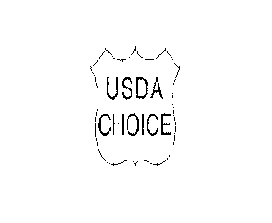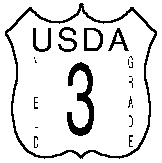Beef Grade
Beef Grade and Steak Pefection
By
Joe O'Connell,
Food Writer
First posted 3 July 2003 at 1840 GMT
Last updated 30 November 2003 at 1724 GMT
LOS ANGELES, California — Chefs who aspire to Steak
Perfection understand the system for awarding a USDA Beef
Grade (or the system used in their own country). This website
and the Steak Perfection book provide detailed
information so that everyone can learn how a beef grade is determined,
what it means, and how it relates to steak
perfection.
Most
beef sold around the world is regulated by the various countries.
In the United States, beef is graded by the USDA (United States
Department of Agriculture)
and includes both a quality grade and a yield grade. See the
U.S. Department of Agriculture's website for more information.
Current grading system
The USDA inspectors mark beef carcasses (including full-, half- and
quarter-carcasses) with a quality grade mark. Quality grading is
designed
 to distinguish between differences in palatability among carcasses.
In red meat carcasses the quality grade has served as a nationwide
guide to the eating qualities of meat, including its tenderness,
juiciness, and flavor.
to distinguish between differences in palatability among carcasses.
In red meat carcasses the quality grade has served as a nationwide
guide to the eating qualities of meat, including its tenderness,
juiciness, and flavor.
Beef quality attributes considered to be of value include:
(1) maturity, (2) marbling, (3) texture of the lean,
(4) firmness of the lean and fat, and (5) color of the lean and
fat.
The quality grade is determined by considering the degree of
marbling and firmness as observed in the cut surface of the rib eye
in relation to the maturity of the carcass. In other words, a
younger beef cannot be expected to have the same marbling in the rib
eye as the older one.
There are eight grades of beef, although only the first
three or four are usually sold in markets. These grades are, in
descending order of quality:
- Prime
- Choice
- Select
- Standard
- Commercial
- Utility
- Cutter
- Canner
The first two grades -- prime and choice -- are top quality, the
select grade is average. The other grades should not be used in
most circumstances.
Three Choice Grade levels
The Choice Grade represents beef which is 15% more marbled than
Select. The Choice Grade covers a very broad spectrum of beef.
Within the Choice Grade, there are three different levels of quality,
which are usually called:
- Small marbling
- Modest marbling
- Moderate marbling
Moderately marbled USDA Choice is the top cut, just one step short
of Prime. Branded beef often uses this top cut of Choice for its
program (see below).
Decline in beef quality
Chefs should know a little about the history of the
grading system in order to understand how a change in the grading
system led to a decline in the quality of beef. Experts agree
that the quality of beef today is much worse that it was twenty years
ago. This will explain the reason.
Prior to 1987, the top three grades of beef in the U.S. were Prime,
Choice and Good. The major difference was the degree of
marbling: Prime is 15% more marbled than Choice, which is 15%
more marbled than Good. About three-fourths of grain-fed beef
was graded Prime or Choice.
The National Cattlemen's Association (NCA) started a nationwide
consumer movement for lean beef. At the request of the NCA,
Texas A&M University produced the "National Consumer Retail Beef
Study", which began the "War on Fat". The study recommended that
consumers be educated to purchase lean beef.
The problem was that beef graded Prime and Choice were fatter,
and consumers had learned that beef graded Good was lean but tough.
The "solution" - so typically the resort of those with poor ideas
but a "we know better than them" conviction - was to change the
definition. That is, change the name of the grade from Good to
Select, so that consumers could be "fooled" into thinking that a
lean cut was better than one with fat. In other words,
consumers would be "re-educated" (some would call the government's
efforts nothing less than propaganda) to prefer lean, lower-quality
beef.
As opposed to the fraudulent "solution", the fact is that the
taste of beef results from marbling (intermuscular fat). Prime
Grade beef tastes better than lowers graded beef because it has more
marbling - more fat. Conversely, leaner beef has less marbling
and less taste.
In the 1980s, some people argued that consumers deserved to be
educated, not brain-washed. They urged the industry to educate
consumers on the following facts: (1) marbled beef
tastes better than leaner beef; (2) marbled beef is more
expensive than leaner beef; but (3) eating too much marbled
beef is not healthy. Those who urged this lost the argument to
others who wanted to "fool the consumers" with a combination of a
name-change coupled with the false and incomplete message that "lean
beef tastes better and is healthier". Both statements are
false: lean beef does not taste better, and lean beef if not
healthier.
Skeptics may argue that the beef industry succeeded beyond their
wildest expectations and hopes. After all, now 80% of Prime
Grade U.S. beef is exported (mostly to Japan) at premium prices;
U.S. consumers are now buying low-quality beef without objection;
and the low-quality beef costs the industry much less to produce
(yet it now produces the same revenue as previously received for
high-quality beef).
For more information, see Robb Walsh's story, "A
Matter of Fat".
In 1987, as a result of the study, the USDA Good Grade was renamed
the Select Grade. Since then, consumers have been "educated"
into believing that lean beef like Select Grade is a high quality
grade, and beef of the highest quality has declined in availability
(quantity) and, according to some, even in quality. According to
Marilyn Spiera, President of the famous Brooklyn steakhouse, Peter
Luger, "A lot of the meat they now sell as 'Prime' wouldn't even be
graded 'Choice' 35 years ago." Quoted by John Mariani,
Ready for Prime Time.
CAB and other branded beef programs
Because the 1987 changes led consumers to experience a decrease in
the quality (taste) of beef, a market for higher quality beef
developed, which itself led to the development of branded beef
programs. The best marketed and thus best known program now is
the Certified Angus Beef (CAB).
CAB uses the top third of the Choice Grade, which is called the
Moderately Marbled level of Choice. With the consumer confusion
caused by the USDA's changes, CAB allows consumers an alternative to
the confusing (for them) government grading. According to a
report, "After the USDA issues a grade, an Angus grader comes
through and stamps the meat that fits their program. What they
are taking is, by and large, the top level of USDA Choice." CAB
and other programs market their beef without the USDA labels and pass
off as the highest quality those cuts which are not quite Prime Grade
but are nevertheless affordable.
Most consumers and even many barbecue cooks believe incorrectly
that CAB is Prime Grade. Of course, that is exactly what CAB
wants consumers to believe (and it is the reason that CAB itself
does not usually label the USDA Grade on its products).
CAB is only one of the many branded beef programs. Sterling
Silver and others are also widely available.
In addition, there are a new generation of "organic", "natural" and
"hormone-free" beef sold in the U.S. While these in the past had
been available only from "health food stores", they are now becoming
commonly available in supermarkets.
Yield grades
The USDA grades beef with a yield grade, in addition to the quality
grade. Yield grading is designed to illustrate the percentage of
lean meat that can be obtained from a beef carcass. The
yield grade of a beef carcass is determined by four characteristics:
(1) amount of external fat; (2) amount of kidney, pelvic, and
heart fat; (3) area of the rib eye muscle; and, (4) warm
carcass weight.
There are five yield grades numbered 1 through 5. Beef
carcasses in Yield Grade 1 have the highest degree of cutability while carcasses in Yield
Grade 5 have the lowest. (Cutability refers to the
proportion of the carcass weight that is actually saleable at the
retail counter.) Yield grades are applied without regard to
quality grade. Grades such as USDA Prime-1, Choice-1, Choice-2,
or any combination of quality grade and yield grade may be applied to
the carcass.
Grade 1 have the highest degree of cutability while carcasses in Yield
Grade 5 have the lowest. (Cutability refers to the
proportion of the carcass weight that is actually saleable at the
retail counter.) Yield grades are applied without regard to
quality grade. Grades such as USDA Prime-1, Choice-1, Choice-2,
or any combination of quality grade and yield grade may be applied to
the carcass.
Grading not mandatory
Commercial produced beef in the United States is not required to be
officially graded. For example, most States have a department to
inspect and grade meat and poultry, but federal law prohibits the
interstate transportation of any meat or poultry that has not been
federally inspected.
Related information
Related information:
|